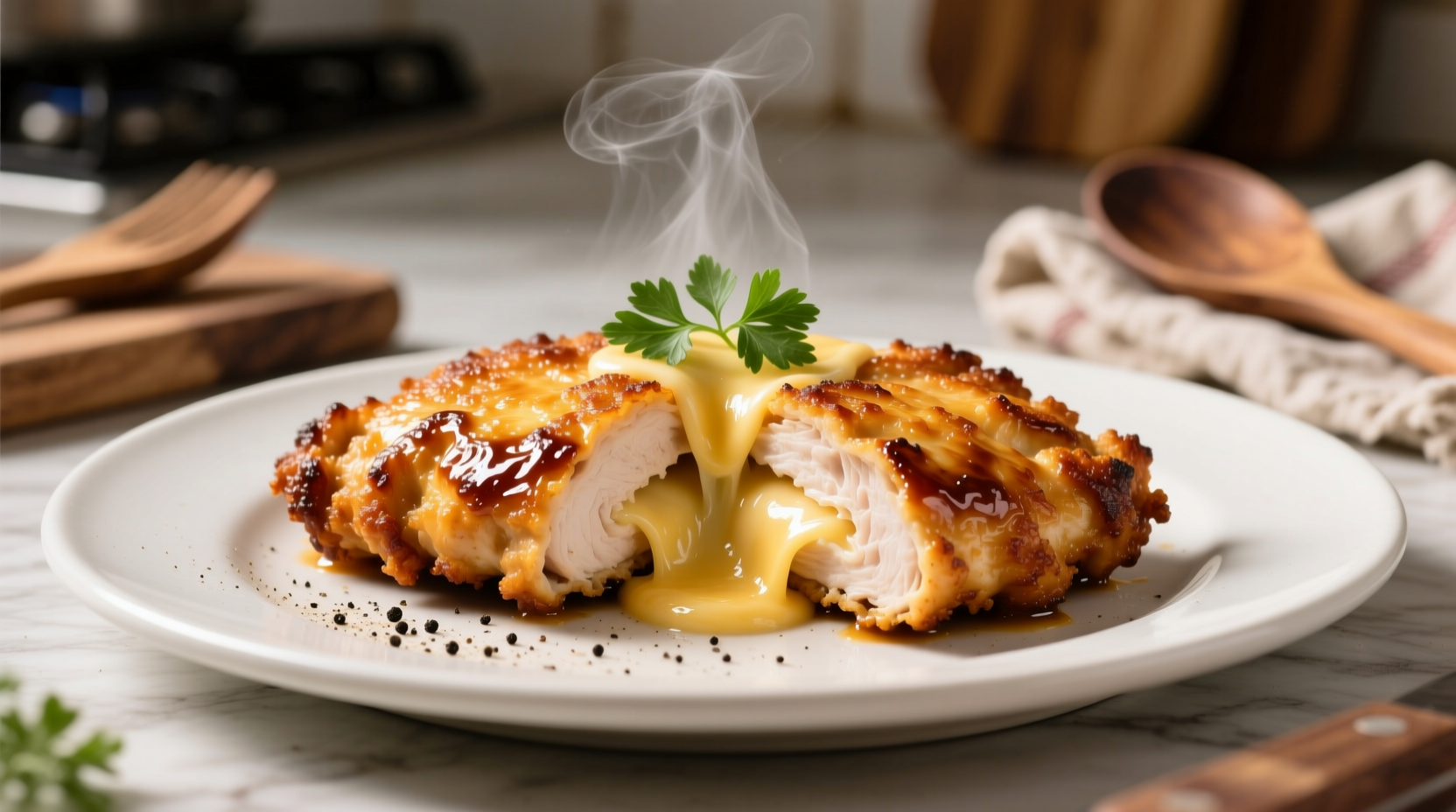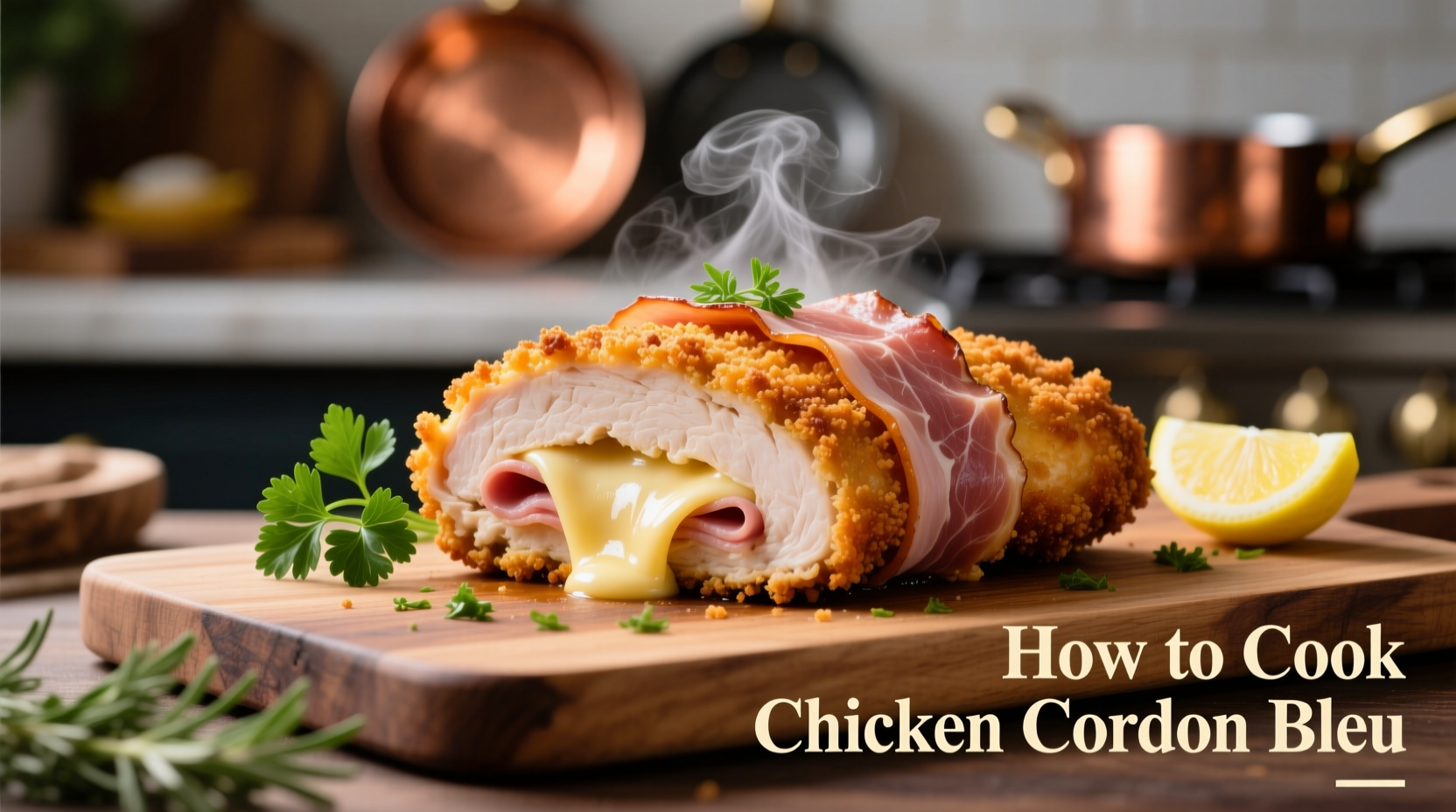Master the art of making perfect chicken cordon bleu with this step-by-step guide. You'll learn the traditional preparation method, ideal cooking temperature (375°F/190°C), and professional techniques to achieve a crispy golden crust without drying out the chicken. This comprehensive recipe includes ingredient substitutions, assembly tips to prevent bursting, and food safety guidelines for perfectly cooked poultry every time.
The Essential Guide to Perfect Chicken Cordon Bleu
Chicken cordon bleu, a beloved French-inspired dish featuring tender chicken breast wrapped around ham and Swiss cheese, has become a classic in home kitchens worldwide. While many versions exist, the authentic preparation requires specific techniques to achieve that perfect balance of crispy exterior and molten cheese center. This guide reveals the professional methods that transform this seemingly complex dish into an achievable weeknight dinner.
Understanding Chicken Cordon Bleu: History and Evolution
Despite its French name ("blue ribbon"), chicken cordon bleu likely originated in Switzerland during the mid-20th century. The dish evolved from traditional French "cordon bleu" cooking competitions where chefs wore blue ribbons. By the 1950s, American cookbooks began featuring simplified versions using chicken breast instead of the more traditional veal.
| Era | Development | Key Changes |
|---|---|---|
| 1940s-1950s | Swiss origin | Veal-based preparation with ham and cheese |
| 1960s | American adaptation | Chicken substitution for veal, simplified breading |
| 1980s-present | Global popularity | Regional variations, air fryer adaptations |
Why Traditional Methods Beat Shortcuts
Many home cooks struggle with chicken cordon bleu because they skip essential preparation steps. The most common issues include:
- Cheese leaking during cooking (from improper sealing)
- Dry, overcooked chicken (from incorrect temperature)
- Soggy coating (from inadequate breading technique)
Professional chefs address these problems through specific techniques that maintain food safety while maximizing flavor and texture.
Authentic Ingredients Checklist
For the most authentic chicken cordon bleu, gather these ingredients. Note that ingredient quality significantly impacts the final result:
- 4 boneless, skinless chicken breasts (6-8 oz each)
- 8 thin slices Black Forest ham (about 4 oz total)
- 4 oz high-quality Swiss cheese, cut into 8 thin slices
- 1 cup all-purpose flour
- 2 large eggs, beaten with 2 tablespoons water
- 1½ cups panko breadcrumbs
- 1 teaspoon paprika
- ½ teaspoon garlic powder
- Salt and freshly ground black pepper to taste
- ¼ cup vegetable oil (for pan-frying)
Ingredient Notes: Traditional Swiss cheese is essential for proper melting properties. Avoid pre-shredded cheese which contains anti-caking agents that prevent smooth melting. Black Forest ham provides the ideal saltiness and texture.
Essential Equipment for Success
Having the right tools makes the preparation process smoother and more successful:
- Cutlet mallet or heavy skillet (for pounding chicken)
- Plastic wrap (for pounding without mess)
- Three shallow dishes (for breading station)
- Meat thermometer (critical for food safety)
- Baking sheet with wire rack (for even cooking)
- Toothpicks or kitchen twine (for securing)
Step-by-Step Preparation Process
1. Preparing the Chicken
Place chicken breasts between sheets of plastic wrap and pound to ¼-inch thickness using a cutlet mallet. Start from the center and work outward to maintain even thickness. Properly pounded chicken should measure 5-6 inches across. This step is crucial for even cooking and proper rolling.
2. Assembly Technique
Layer ingredients as follows on each chicken cutlet:
- 2 slices ham (slightly overlapping)
- 2 slices Swiss cheese (centered on ham)
Fold the sides inward, then roll tightly from the thicker end to the thinner end. Secure with 2-3 toothpicks. Important: The USDA Food Safety and Inspection Service recommends cooking poultry to an internal temperature of 165°F (73.9°C) to eliminate harmful bacteria. Proper rolling technique prevents cheese leakage while allowing even heat distribution.
3. Professional Breading Method
Create a breading station with three shallow dishes:
- Dish 1: Flour mixed with salt and pepper
- Dish 2: Beaten eggs with water
- Dish 3: Panko breadcrumbs mixed with paprika and garlic powder
Dredge each roll first in flour (shaking off excess), then egg mixture, then breadcrumbs, pressing gently to adhere. For extra-crispy results, repeat the egg and breadcrumb steps. Chill assembled rolls for 20 minutes before cooking to set the coating.
4. Cooking to Perfection
For optimal results, use a combination cooking method:
- Heat oil in oven-safe skillet over medium heat (350°F)
- Sear rolls for 2-3 minutes per side until golden brown
- Transfer skillet to preheated oven at 375°F (190°C)
- Bake for 15-18 minutes until internal temperature reaches 165°F
This two-step method ensures a perfectly crispy exterior while cooking the chicken thoroughly without drying it out. The panko breadcrumbs create superior crunch compared to regular breadcrumbs.

Avoiding Common Mistakes
Even experienced cooks encounter problems with chicken cordon bleu. Here's how to avoid the most frequent issues:
- Cheese leakage: Ensure chicken is pounded evenly and completely covers the filling. Chill rolls before cooking to help the cheese set initially.
- Dry chicken: Never skip pounding the chicken to even thickness. Use a meat thermometer to verify 165°F internal temperature.
- Soggy coating: Maintain proper oil temperature (350°F) during searing. Excess moisture is the enemy of crispiness.
- Bursting rolls: Don't overfill. Leave ½ inch border around edges when assembling.
Serving and Pairing Suggestions
Traditional French accompaniments enhance the dining experience:
- Steamed asparagus with lemon butter
- Garlic mashed potatoes
- Simple green salad with Dijon vinaigrette
- Dry white wine such as Chardonnay or Sauvignon Blanc
Cut diagonally before serving to showcase the beautiful spiral of ham and cheese. The ideal presentation includes a golden-brown exterior with visible cheese oozing slightly from the cut edge.
Storage and Reheating Guidelines
For food safety, follow these storage recommendations from the USDA:
- Refrigerate leftovers within 2 hours of cooking
- Store in airtight container for up to 3-4 days
- Freeze uncooked assembled rolls for up to 2 months
To reheat without compromising texture:
- Preheat oven to 350°F (175°C)
- Place on wire rack over baking sheet
- Reheat for 10-15 minutes until internal temperature reaches 165°F
- Avoid microwaving which creates soggy coating
Frequently Asked Questions
Can I make chicken cordon bleu without toothpicks?
Yes, you can secure chicken cordon bleu without toothpicks by using kitchen twine or creating a tight roll with the sides folded inward before rolling. Another option is to place the seam side down during cooking, as the breading will help hold it together. For best results, chill the assembled rolls for 20 minutes before cooking to set the shape.
What's the ideal internal temperature for chicken cordon bleu?
The USDA Food Safety and Inspection Service recommends cooking chicken to an internal temperature of 165°F (73.9°C). Use an instant-read thermometer inserted into the thickest part of the chicken (avoiding the cheese filling) to verify doneness. Cooking to this temperature ensures food safety while maintaining optimal moisture.
Why does my cheese leak out during cooking?
Cheese leakage typically occurs when the chicken isn't pounded evenly, there are gaps in the wrapping, or the rolls aren't properly chilled before cooking. Ensure the chicken completely covers the filling with no thin spots, seal the edges well, and refrigerate assembled rolls for at least 20 minutes before cooking. Using high-quality Swiss cheese (not pre-shredded) also helps prevent excessive leakage.
Can I bake chicken cordon bleu instead of pan-frying?
While you can bake chicken cordon bleu entirely in the oven, the results won't be as crispy. For best texture, sear the rolls in a hot skillet for 2-3 minutes per side to create a golden crust, then finish baking at 375°F for 15-18 minutes. If baking only, spray the rolls with cooking oil before baking to help the coating brown properly.
What are good substitutions for Swiss cheese?
While Swiss cheese is traditional for its excellent melting properties, Gruyère makes a delicious alternative with similar meltability and nutty flavor. Emmental or provolone can also work well. Avoid cheeses with high moisture content like mozzarella, as they can cause excessive leakage. For a stronger flavor, consider a blend of Swiss and a small amount of sharp cheddar.











 浙公网安备
33010002000092号
浙公网安备
33010002000092号 浙B2-20120091-4
浙B2-20120091-4